The UEFA Champions League is back! In the second leg of the last 16, Manchester City are facing Real Madrid at the Etihad Stadium. Pep Guardiola’s team enjoyed one-goal margin and two away goals from the previous clash in February, but we know Zinédine Zidane’s men will not give up the chance to grab another trophy.
This tactical preview is showing you some possible tactics of Manchester City play against Real Madrid. The below standpoints are provided after I watched all 57 games of Pep in the 2019/20 campaign, the content and tactics included in the analysis would not be niche.
Predicted lineups
City (4-3-3): Ederson; Kyle Walker, Nicolás Otamendi, Aymeric Laporte, João Cancelo; Rodrigo Hernández, İlkay Gündoğan, Kevin De Bruyne; Riyad Mahrez, Raheem Sterling, Gabriel Jesus
I chose Otamendi as Laporte’s partner since Eric García was young and inexperienced, and rumours have been reporting that he is returning to Barcelona. The left-back is Cancelo because of his good training attitude and performance, while Oleksandr Zinchenko did not have many chances after the Southampton loss. Benjamin Mendy is suspended for a second yellow. At the midfield, Gündoğan and Rodri are operating as a double-pivot, especially the German international offers something Phil Foden and Bernardo Silva do not. I did not place the front three wrongly, Sterling might play as a striker as Jesus would be more committed to his defensive duties. The positions are not fixed as we have seen the fluidity and positional interchanges of Pep’s men previously.
Madrid (4-3-3): Thibaut Courtois; Dani Carvajal, Éder Militão, Raphaël Varane, Ferland Mendy; Casemiro, Federico Valverde, Toni Kroos; Marco Asensio, Karim Benzema, Eden Hazard
Since Sergio Ramos was sent off in the last clash, he is suspended and probably Militão is replacing him, unless Zidane wants an extremely aggressive team, so Casemiro plays in that position. At the midfield, I left out Luka Modrić because of his off-the-ball outputs. It is too risky to play the Croatian midfielder with Kroos without Valverde balancing the team, unless the team sacrifices a winger position for the youngster. We are not sure whether Hazard is fully fit or not, as well as Asensio. These two spots might be replaced by Vinícius Júnior and Isco.
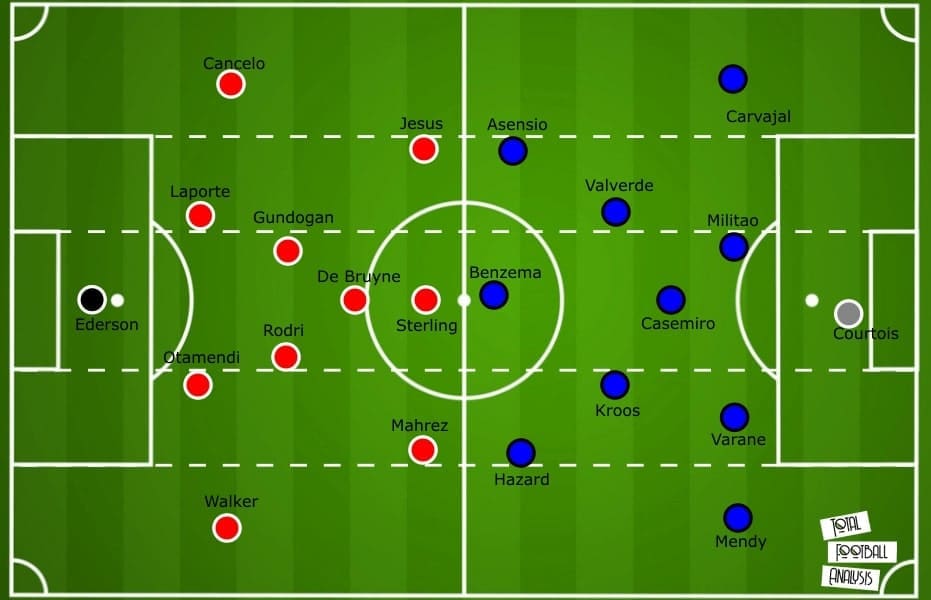
Positional plays
In this game, I believe City are going to abandon the inverted full-back approach, especially the tradition 3-2-5 approach will leave the defence being exposed. Instead, operating Gündoğan as a partner of Rodri is workable, and it is a proved success in the first leg.
Therefore, the full-backs are going to provide the width, attacking the wide zones in this game. At the centre, City should be able to create an overload or at least an equality thanks to the technical and passing ability of Ederson. The Brazilian goalkeeper has tried to play as a part of the back three in the build-up, and he should ensure the fluidity of ball circulation at the backline.
This system offers the flexibility to attack. The key is to roam Sterling and Mahrez’s positions between the half-spaces and at the wide zone. Assuming the wide shape of City will match the Madrid full-backs perfectly, spaces should be available behind Carvajal and Mendy. This would also allow the wingers to create 1 v 1 circumstances against the centre-backs. Without Ramos’ aggressiveness, this is uneasy for Madrid to deal with them.
I tend not to drop Rodri between the centre-backs, as the manipulation of the second line is important. Placing two players in the second layer, like a boxed shape or a 3-2 shape is better to connect the centre-backs at either half-spaces. Also, this shape generated two passing triangles on each flank. The strengthened linkage is a leeway to escape from the high press if Madrid pressed so high and overloaded the centre.
Another intention is to put De Bruyne between the lines. If Madrid are not pressing high or City easily bypassed the pressure, the Belgian international is closer to the opposition goal. If the opposition midfielders are pressing high, the pivots can be used as the decoys to open the passing lanes for De Bruyne. The forward line of City has to stagger, as providing the height at different positions potentially offer different points to exploit spaces behind the lines by the interfaces passes.
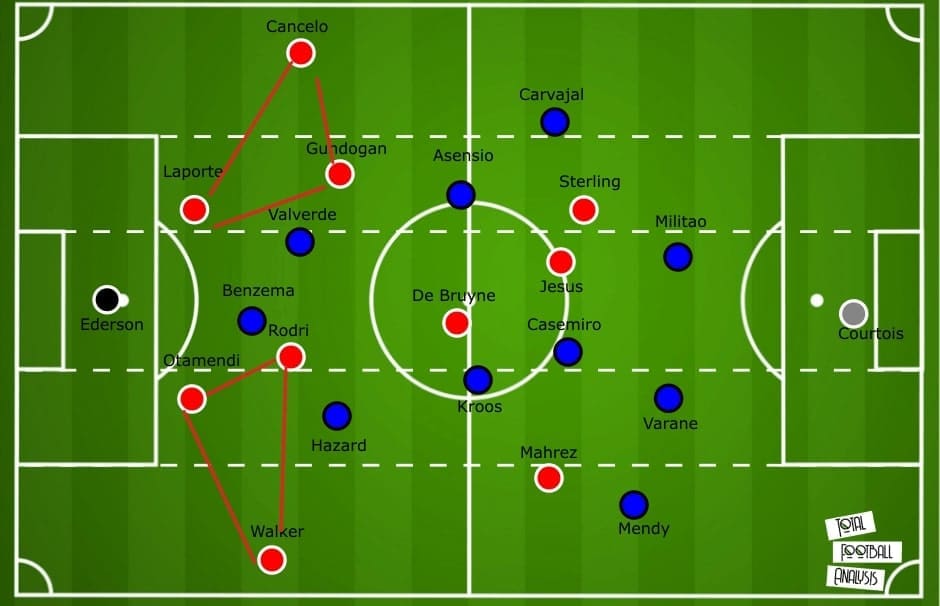
You may argue the above thought experiments are too ideal, and Madrid have so many ways to counter the approach of City, such as curving the runs to access multiple targets. Here, I have some examples to show the flaws of Madrid’s defence and why City should be able to break the press.
Even winning the La Liga, I feel the performance of Madrid is even worse when comparing to the period before the first leg. In terms of defending, they looked solid in numbers, but this was not the situation on the pitch.
The reason that I dropped Modrić is that the midfield needs energy. Madrid is a team without a very clear principle, the players like to go man-to-man but seldom coordinated with each other. The distances of the players are always too large, hence, lost compactness. For example, if the press is a man-orientated scheme, Modrić should go accessing the central target, but the Croatian midfielder is merely instructing a teammate to defend, while himself is marking no one. Kroos is far from the receiver as well, and the Madrid defence was torn apart, filling with spaces and gaps between players.
Another notable player is F. Mendy, who plays as a left-back and temporarily became a part of the midfield. The Madrid full-backs are habited to join the second line to cover the player behind the winger. In other words, now, the backline only has three players, which is an excellent opportunity to exploit. This is why I believed City should put some quick and skilful players to exploit these separated 1 v 1 situations.
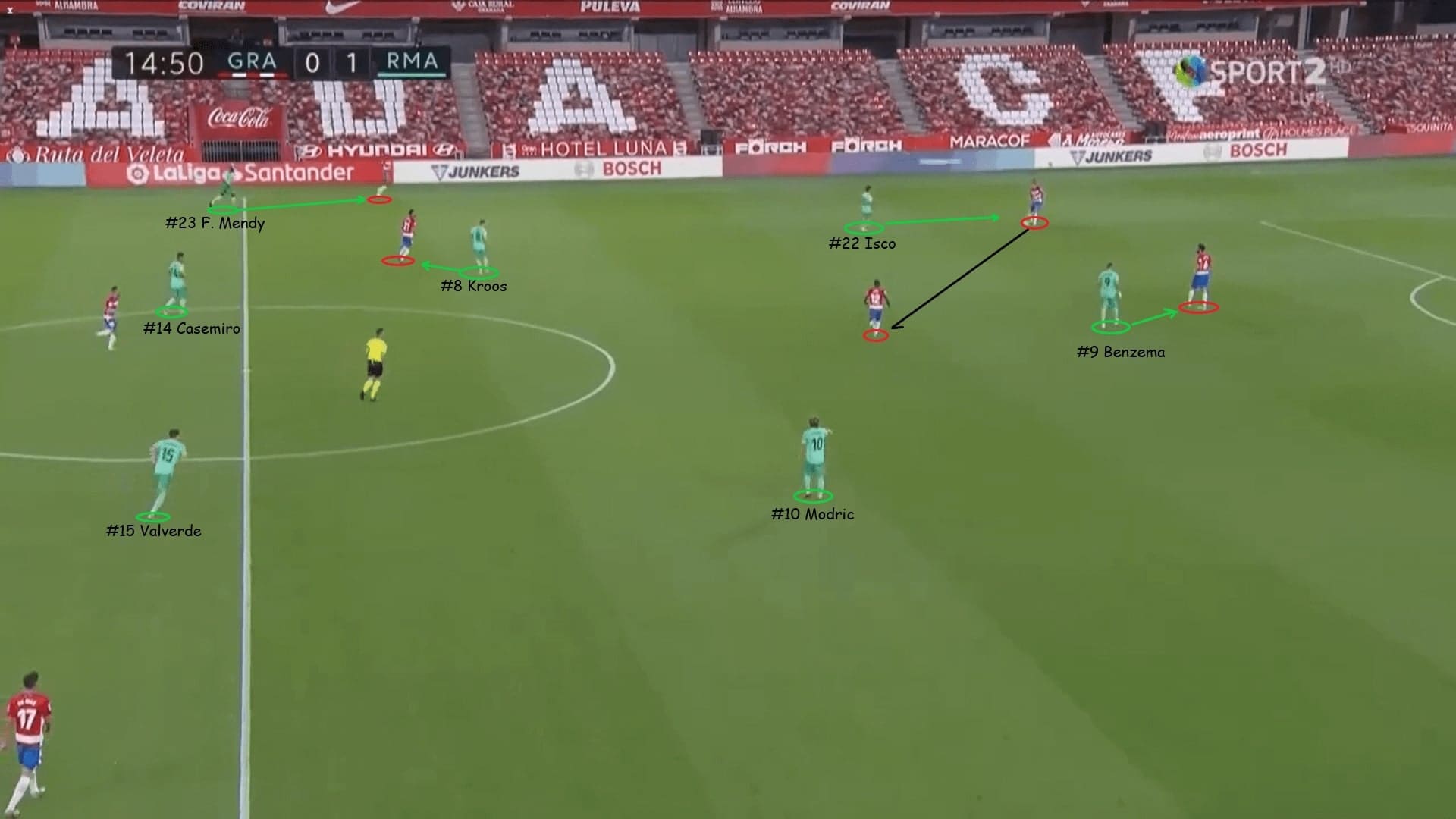
A key for City to break the defensive block is to unbalance the Madrid defence. This is the concept of Guardiola’s philosophy – not moving the ball, move the opponents! When Madrid pressed, players came out but given the stretched structure of the team and the unsynchronized behaviours, moving the ball to the opposite side can easily unbalance the block.
In July games, I have seen Villarreal and Athletic Club doing this, which mostly attributed to the pressing (alone) from Modrić. Even with Benzema marking another target, this two-man temporary first line could easily be bypassed by using a three-man first line in the build-up.
The below scenario is a consequence of the collapsed press. Modrić left his position but it takes too long to get it back. Meanwhile, Rodrygo on the far side did not show the awareness to close the gap and maintain compactness. Plus, we did not see players such as Kroos, Hazard or Vinícius offer the intensity and energy force into a physical game. This light pressure would allow City to hit the ball directly into the final third, just like how Athletic Club did below.
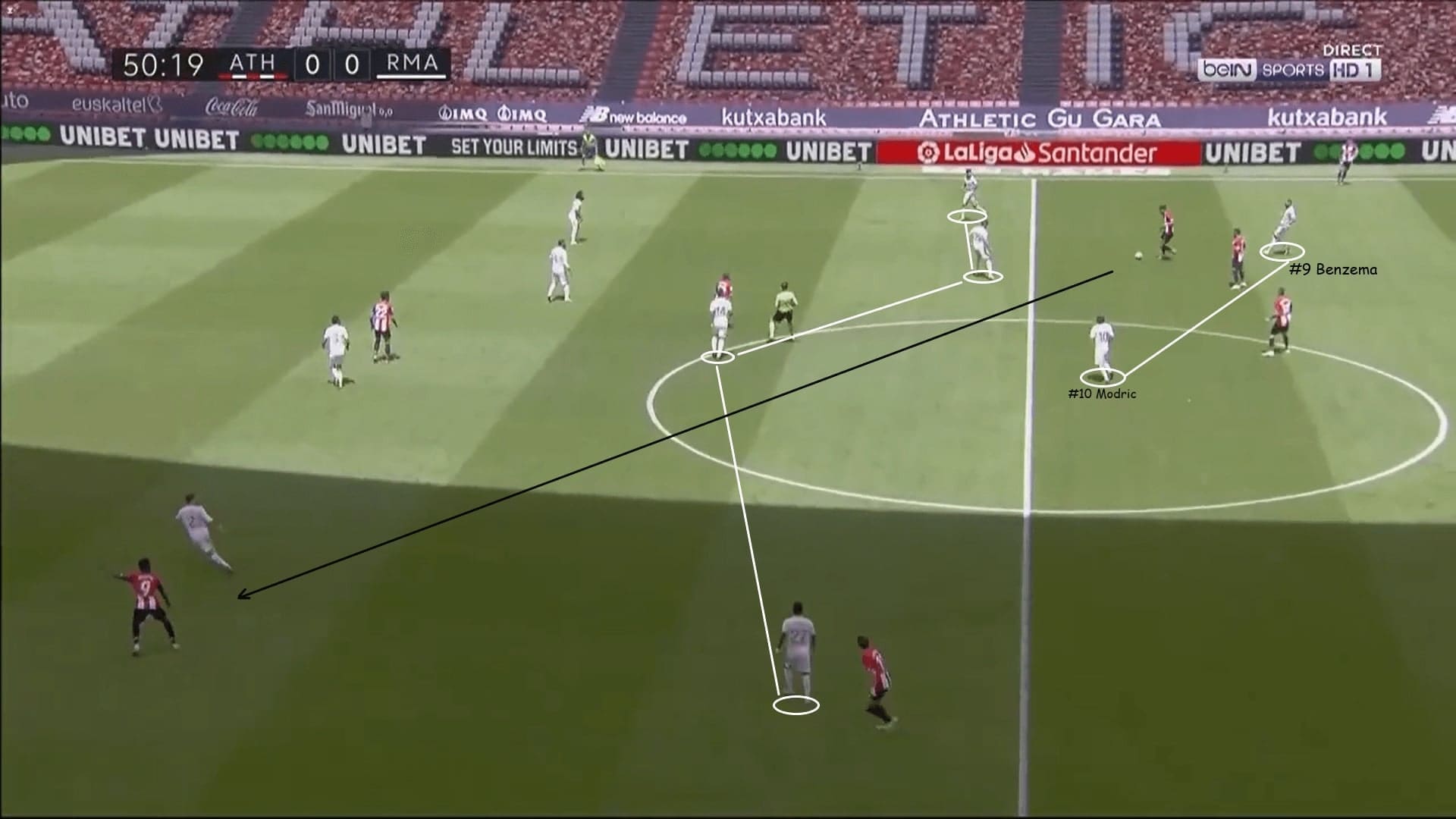
For further elaboration, a pair of wide full-backs are more preferable because of the flexibility of this structure. With Mahrez at the flank, several variations appear from this shape, including dropping Rodri as a part of the back three, rotating the rest of the attacking players. As an example, Mahrez and De Bruyne somehow rotated to disguise the defence, but the manipulation of the second line is always here given the other midfielder (B. Silva) also dropped.
In this shape, City could either play the ball out through the pacey full-backs, or between the lines to find De Bruyne. To avoid the aggressive defensive behaviours from the Madrid the last line, the height of the attack should be provided always, counting on Sterling.
I do not see City are trying to attack slowly, as pushing man forward and left an exposed defence should not be an ideal situation for the Citizens. They should try to speed up the attack, find the free man as quickly as possible. About the benefits of a double-pivot, we are going to explain it in the transition section.
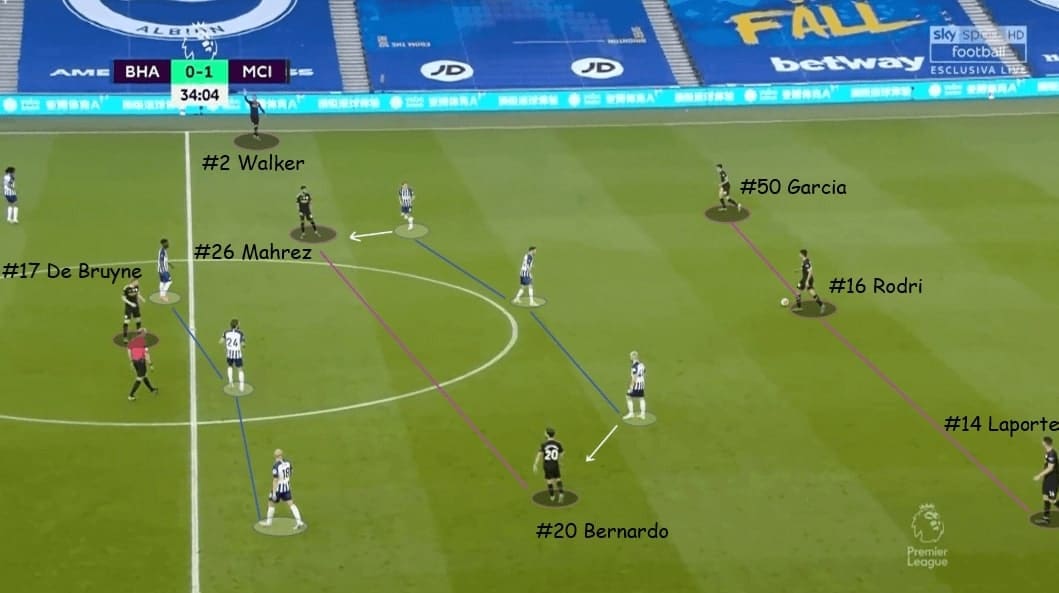
How should they defend?
So, how should City defend to avoid conceding unnecessary goals? I placed Jesus at flanks, but which side is still uncertain, probably it depends on whether Hazard is playing or not. A strength of Madrid this season is their ability to create and attack the underloaded side. With the best passers on this planet – Kroos and Modrić, they managed to hit the weak side with just one pass. Given the quality and supportive movements of full-backs, this is a dangerous scenario and should be paying attention to.
Therefore, I believe City would not committing every player to press Madrid high, as their centre-backs, especially the position of Otamendi is a weak spot, unreliable in 1 v 1 and holding a high line. Usually, the left flank is the overloaded side because of the high full-back – F. Mendy and the winger. My predicted approach is a medium-aggressive one because instead of staying in a passive and compact block, I want to play Mahrez high to look for the counter-attack opportunities, more on this point is explained in the transition section.
City need to a mix of zonal and man-marking scheme to deal with the positional interchanges of Madrid. It should not be very difficult because the timings of the rotations are too early often, hence, the attack of Zidane’s team still lacked the fluidity and flexibility through the process. Placing a double-pivot deeper and in front of the centre-backs is a strategy to deal with the irregular positions of Benzema, as I do not want a centre-back is taken out easily. This part of the defence is going to be zone-oriented.
No matter it was Hazard or Vinícius, Walker should have the ability to contain him, as well as Asensio. A two-sided view is on F. Mendy, who has been in a terrible form since the lockdown. If City are viewing him as a liability, then maybe setting a pressing trap on the Frenchman left-back is a good strategy, hence, moving Jesus to this flank.
But, if Jesus is on the opposite flank, his defensive duties and commitments are important to eliminate the underloaded side issue. As a winger defensively, he should jump to any target when Madrid switched the ball to the opposite flank, while also staying alert to catch any misplaced or low-quality passes.
Another point to mention is the position of Casemiro. Since the Brazilian pivot is not a good passer, he more frequently joins the attack by making the forward runs. However, these runs are not effective enough to create or exploit something. I am thinking whether getting De Bruyne around him can affect him a bit.
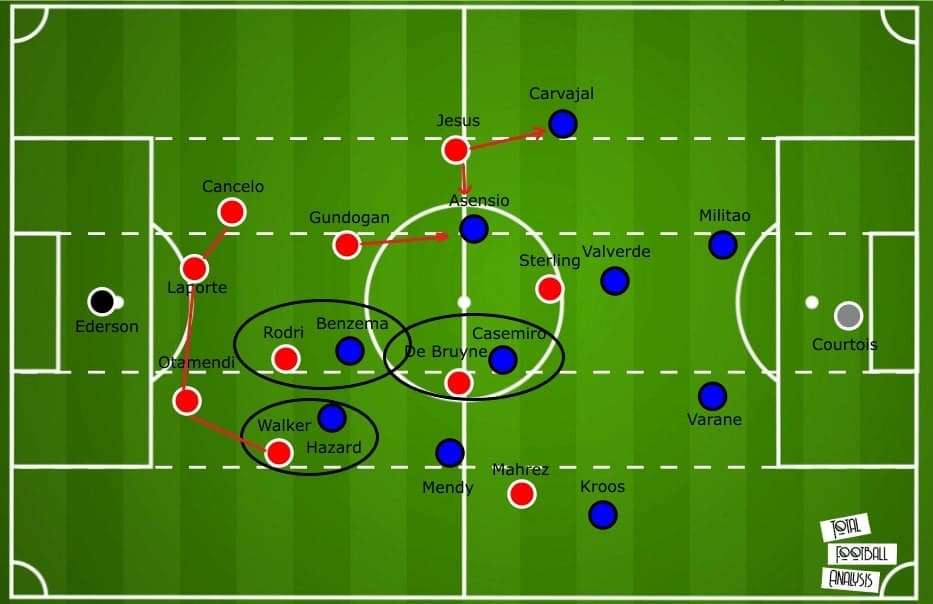
The following images are some examples of Madrid’s offensive inefficacy in the post lockdown period. Although they love to get the ball and organize an attack, the ability to play out from the back is not even good enough to break the block of La Liga teams. They relied on individual qualities, such as Ramos and Kroos to play the out-balls.
Below is an inefficacy of Madrid’s build-up, it is hard to believe they need five players to beat a two-man first line. When Kroos received the ball, he is not quick enough to turn and release the winger often, mostly because of the nature of a dropping movement. F. Mendy is a terrible attacking player, not good enough technically while also not good to read the passing lanes and provide a passing option. Even Benzema could drop to the overloaded flank, the speed of the attack is often too slow and hardly could we expect to see combination – let alone Hazard did not play many games this season.
Also, as Ramos is not playing, I rather prefer to press Kroos strongly and give Varane or Militão more spaces. Undoubtedly the ball-playing ability and defensive solidity of this partnership is nowhere near to a team with Ramos. For some periods, City might press high with curving the presser’s runs, approaching one target while closing another. This should be also enough to force a readable long ball for the defenders.
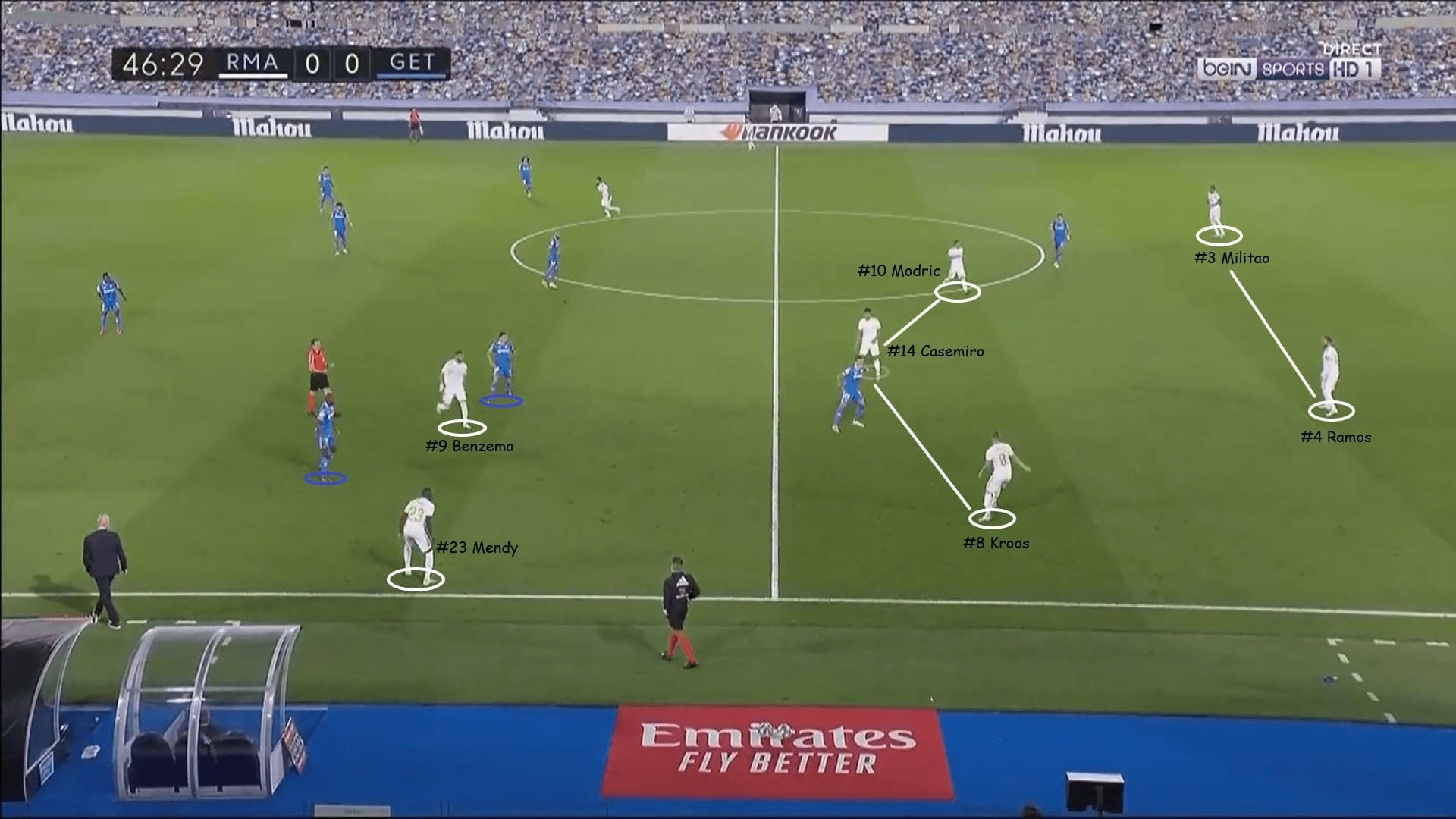
Another potential pressing trap could be set here, it is about exploiting the positional interchanges. A commonly seen pattern is often appearing on the right flank. If Casemiro does not move forward, he drops. And, as a chain effect, Carvajal moves centrally to fill those spaces. Since the defending team often mark the central players, the right-sided centre-back is free to receive the ball.
Then, the chain effect continued as we see the right-winger is dropping to fill the spaces left by Carvajal, which is Valverde’s job below. However, this rotation pattern is not successful because of low moving and passing speed, distanced players (lacked the interconnectedness). If they are really passing to the right-winger with this approach, go get them, the pass is soft and should be accessible.
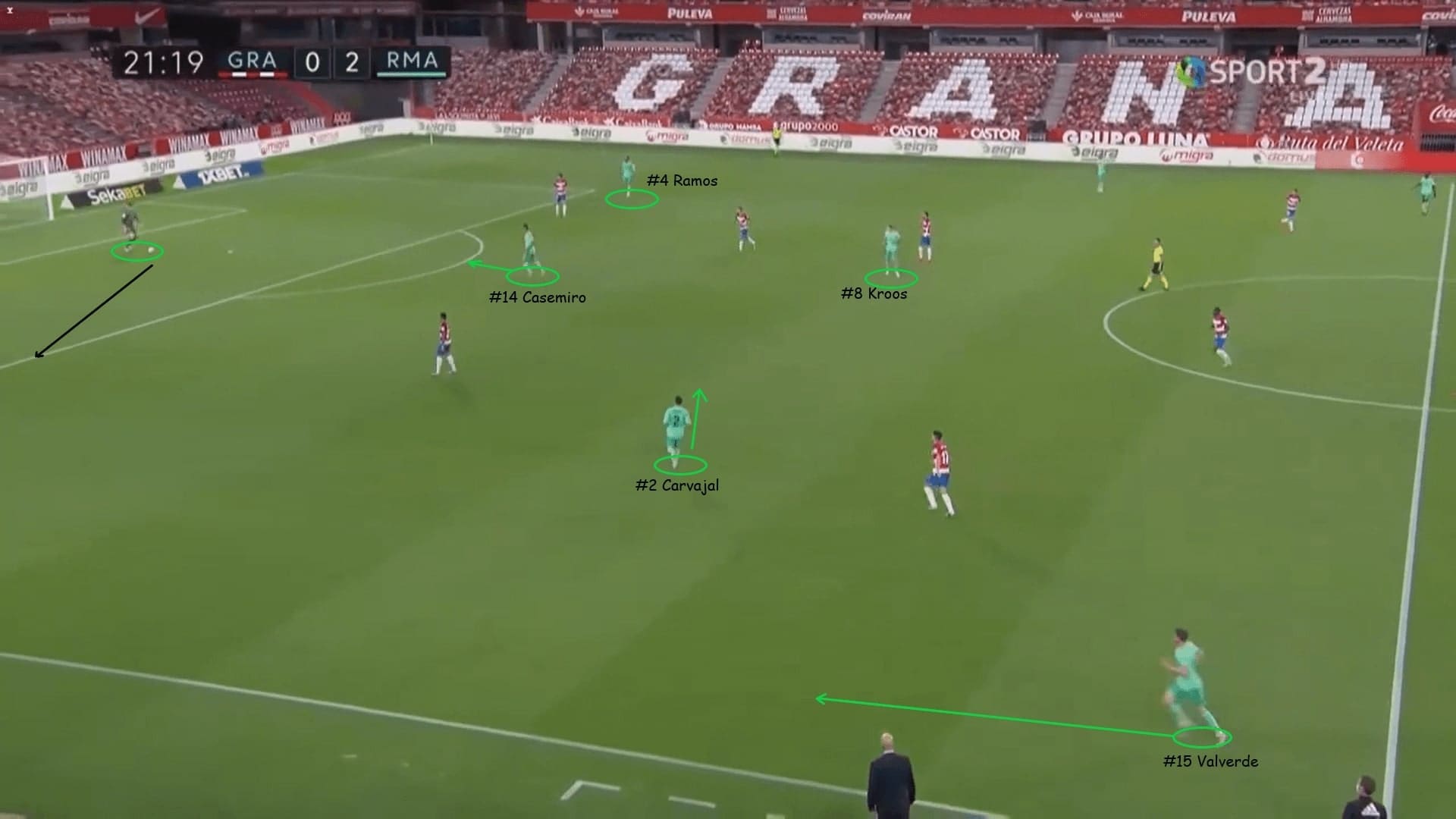
As suggested above, there is one thing that City should avoid – letting Benzema drags the defenders away. The striker is not really a static point on the pitch, instead, he could be everywhere so if we man-marked him, the defensive shape must collapse. This is not a good situation as the wingers, such as Rodrygo and Vinícius would occupy the central positions, they are quick to run between players if gaps are opened.
Instead, although Benzema could be available because of his movements, there is always time to close him because he cannot take on individuals and carries the ball forward. A situation that should be avoided is to place a high line and allows Benzema to face the keeper 1 v 1, like Getafe below. Otherwise, City should be able to nullify the impact of Benzema. Perhaps more emphasis should be paying on the weak side, as the combinations between Rodrygo, Carvajal and a midfielder could be very quick.
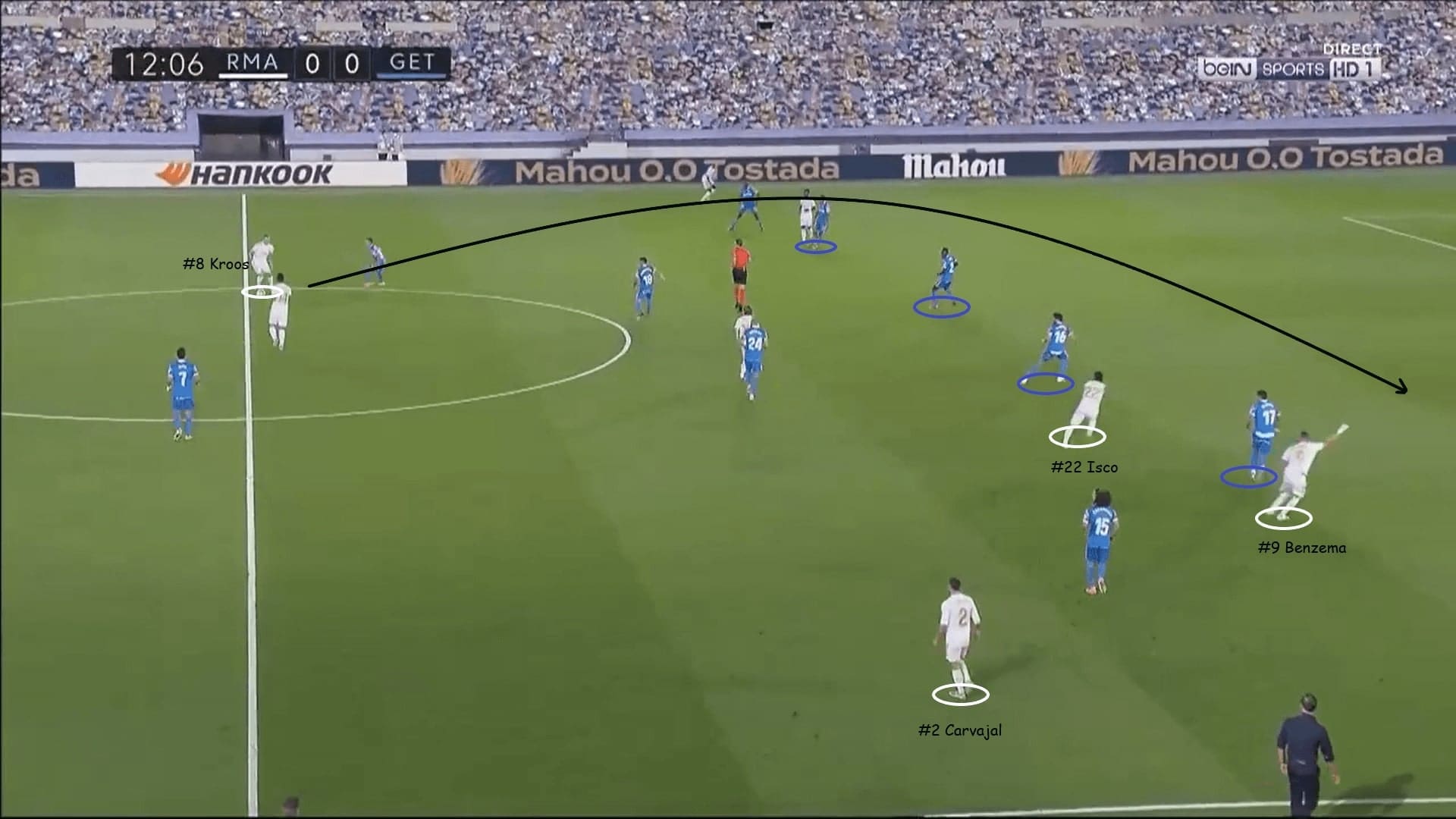
Transition phases are pivotal
About the transitions, City have an advantage – Madrid are forced to attack, and they have to commit men forward. Therefore, I am expecting to see City attacking the exposed defence of Zidane’s team. If they can utilize the qualities of Mahrez and Sterling, this is a very good source of opportunities.
If City are viewing F. Mendy as a weak spot, and a point of the pressing trap, I would place Mahrez higher. There are several benefits of this setup. Defensively, F. Mendy seems to be a free player for Madrid, and once the pass is made, City could apply the pressure from three angles to the left-back. The former Lyon player should not have the ability to escape from the press by playing in-balls or dribbling.
Hopefully, the ball is won on this side of the field, so De Bruyne is easier to connect the front players. Ideally, Mahrez could challenge the centre-back as a 1 v 1 situation, while Sterling creating the separations on the centre-backs. Many possible situations can happen in this case, for example, Mahrez absorbed pressure and Sterling can go from the blindside of Casemrio. Another possible scenario is Mahrez getting past one defender and take the other out, allowing Sterling or even Jesus to join the attack on the far side. Do not forget the ability of De Bruyne to play the through balls.
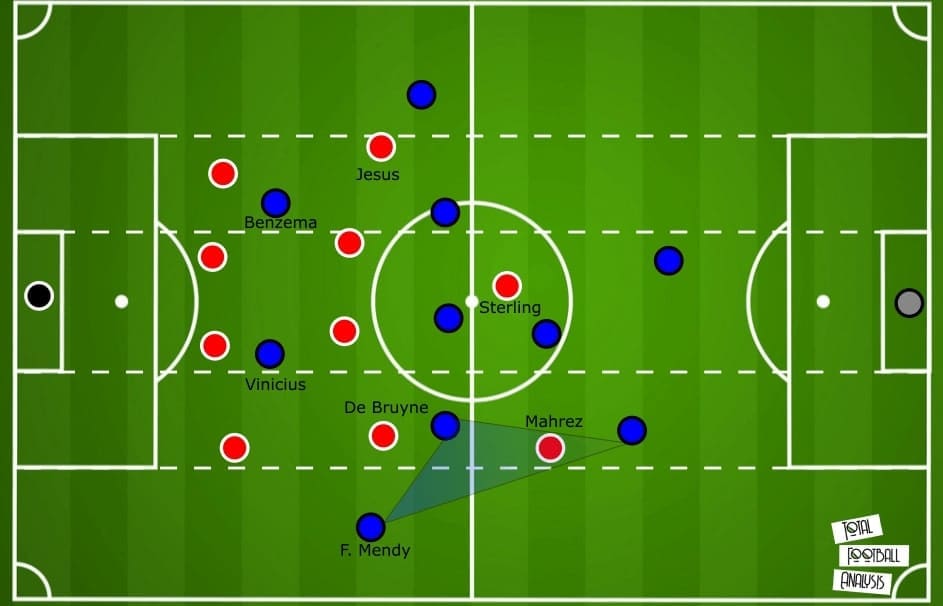
A key to creating beneficial scenarios is to break the first wave of pressure. Madrid’s attack can be very poorly positioned at times, especially when they tried to open the shape and attack. The players are staying on the same horizontal zone and as one straight line, such as the example below.
This suggests one pass to break this line, the attacking players can face the backline directly. Also, note that Casemiro might push high to join the attack, so the pressing player in the first moment can be Kroos or Modrić instead. I do not think it is a very difficult task to escape from this challenge, the key is to get into the positions they needed to exploit and make good use of the momentums.
The Citizens should stay alert and 100% focus to exploit these opportunities.
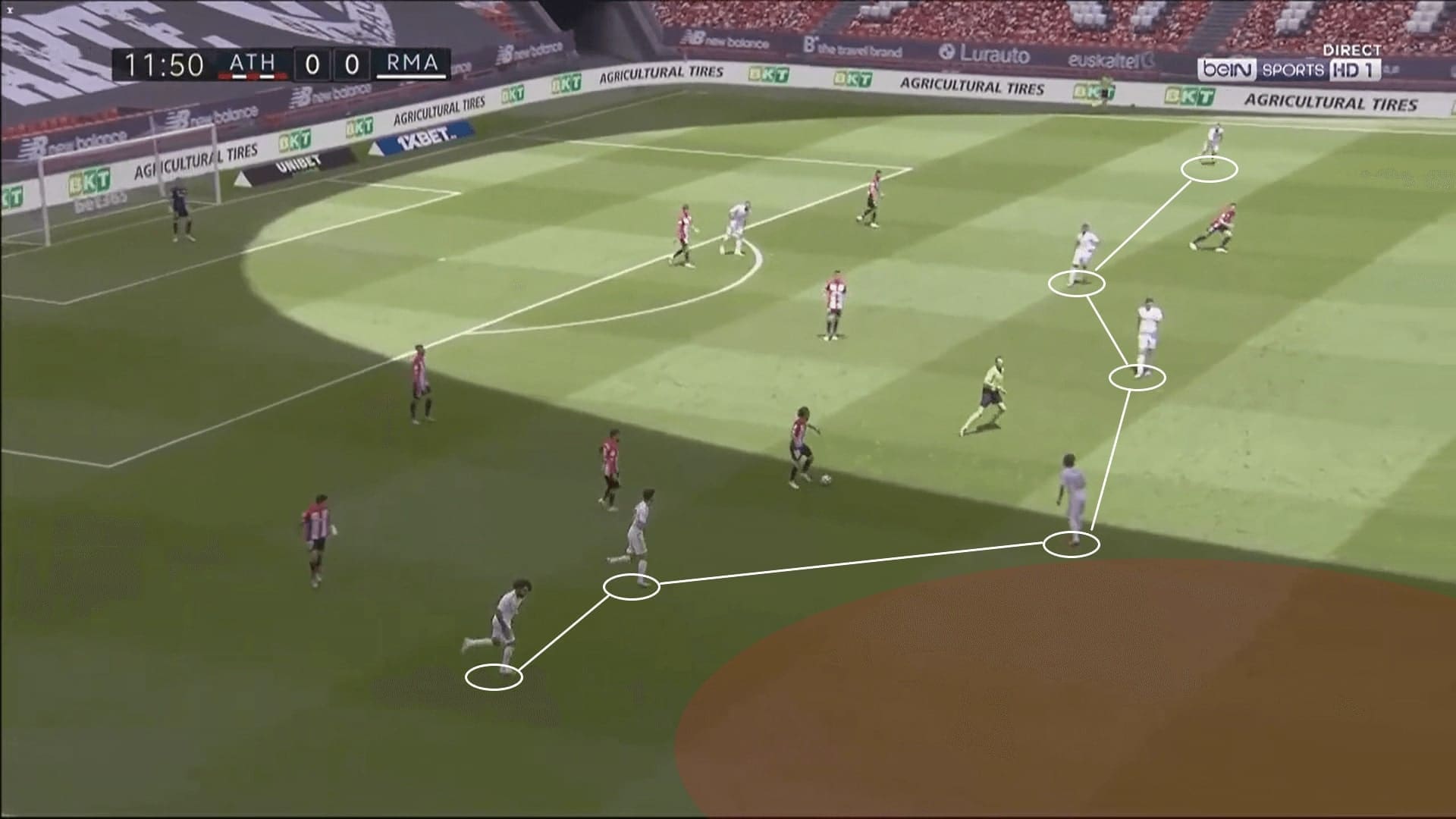
When City are defending in the transitions, they should be aware of the delaying tactics more. Otamendi is too reckless in these situations, making poor challenges and tackles that are unnecessary. His poor defensive and positional awareness also made the Molineux game very difficult for City in December. They need to avoid this!
We totally understand the passing ability of Modrić or Kroos to release the attacking players in the transitions. But, mostly the receiver is Benzema, who is not that quick and skilful to challenge the defence 1 v 1. A notable movement of the Frenchman striker is the wide runs, Benzema likes to make the outside movements to exploit the blindside of the defence. The rest defence of City should always get ready to turn quickly in case a through ball is played.
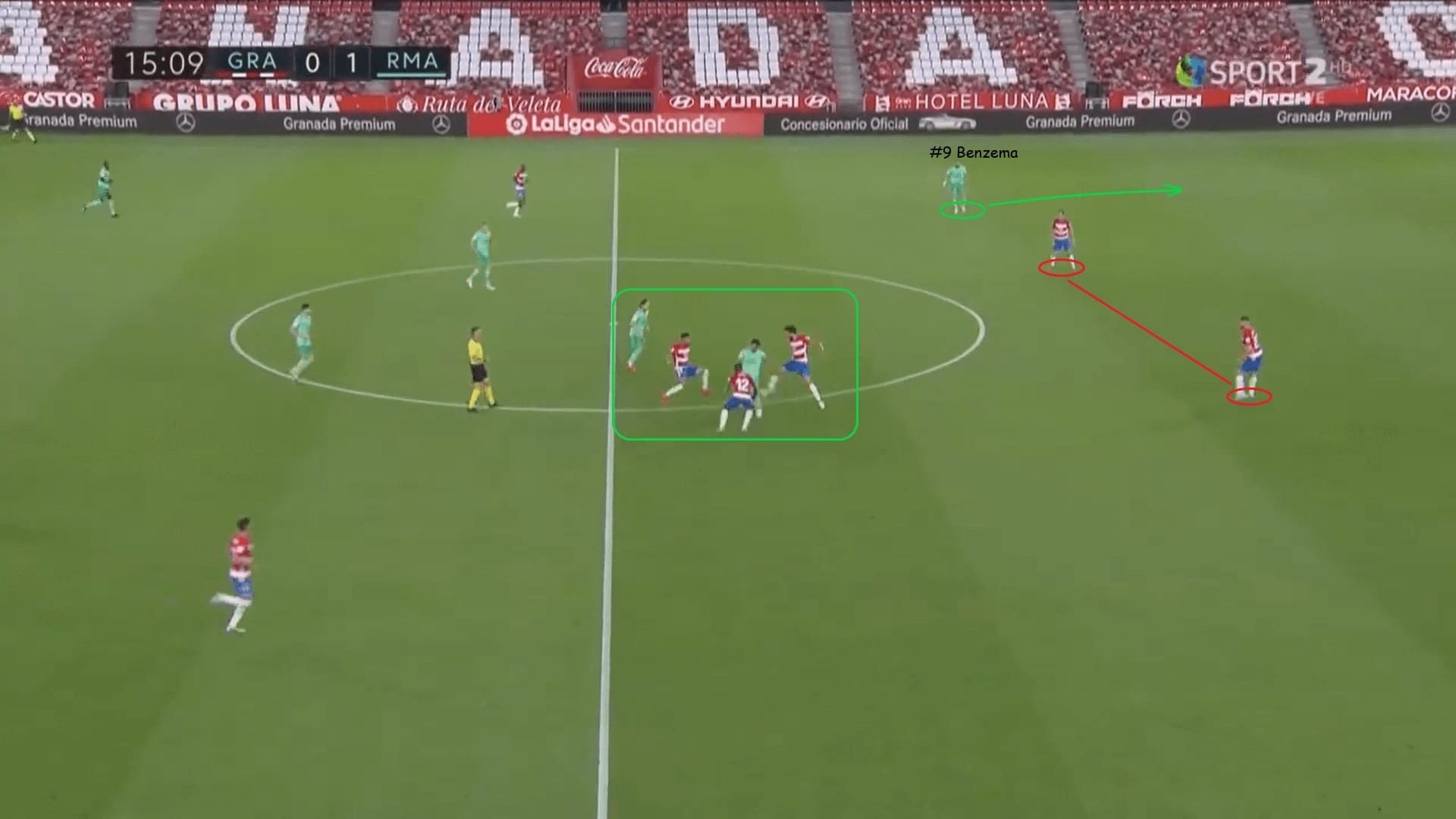
The last reference to explain my suggestion on playing a double-pivot is because of the control of defensive transitions. Pep has tried this tactic several times already, some are successful and included this one against Newcastle. The Magpies have two points to trigger the counter-attacks – Miguel Almirón and Allan Saint-Maximin. If only Rodri is here, it is too risky as one simple pass from the duo could eliminate the pivot.
What a double-pivot provides is the solidity to control this situation. As De Bruyne and Gündoğan controlled the second balls below, both targets are accessible, and City could counter-press immediately and effectively.
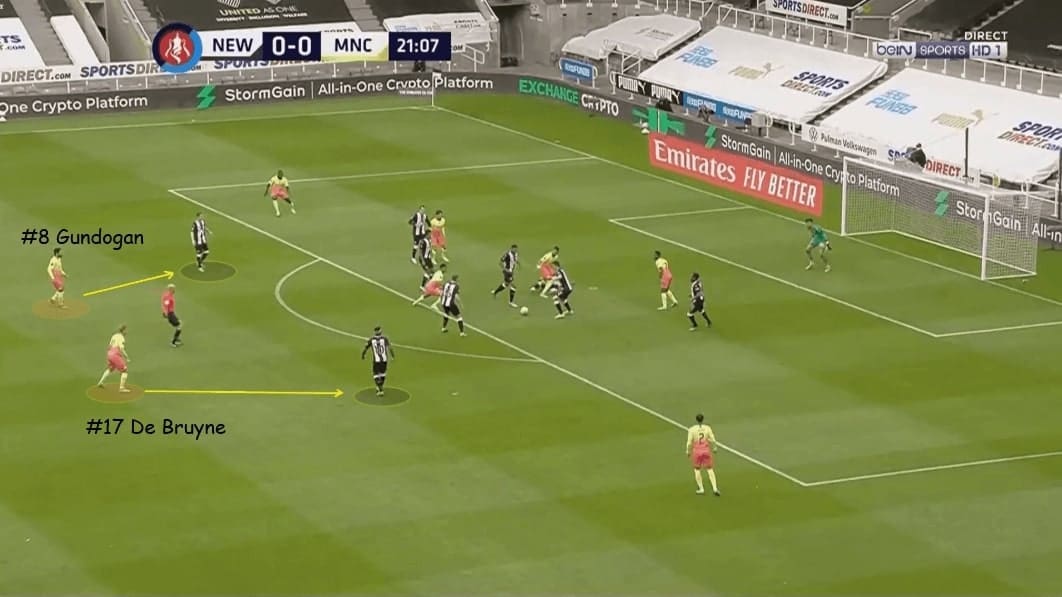
Final remarks
Given the 2-1 result in the last game, and the suspension of Ramos, City are in an advantageous position. However, things are never that simple because they have to show their ability as a contender of the UEFA Champions League. Scoring 102 goals in the Premier League does not mean anything if the team is not clinical in front of the goal. Remember the two league games against Tottenham earlier this season? Pep’s men accumulated 45 shots and 6.02 xG, but only 2 goals and a point are rewarded.
City certainly possessed the quality and conditions to qualify into the quarter-finals, if the VAR does not mess things up. There are no more excuses and it is very reasonable to expect Pep’s men to beat Madrid and progress, no matters what the result is.




Comments